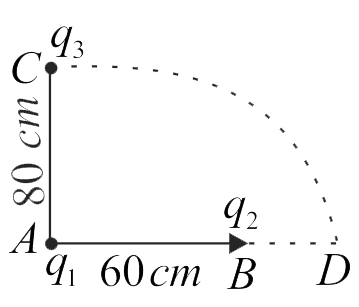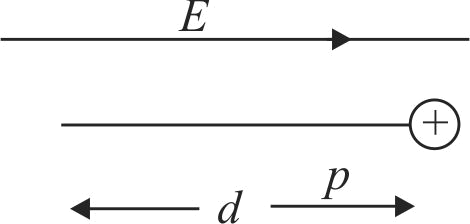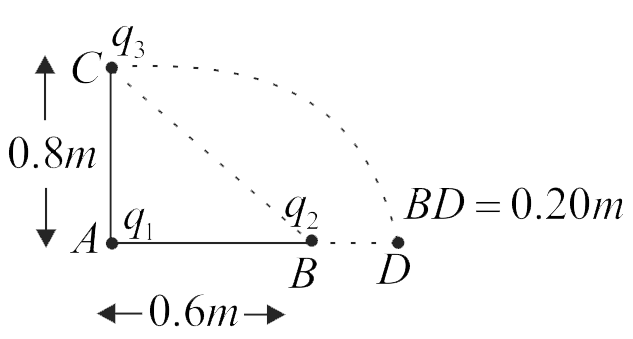359508
Assertion :
For a charged particle moving from point \(P\) to point \(Q\), the net work done by an electrostatic field on the particle is independent of the path connecting point \(P\) to point \(Q\).
Reason :
The net work done by a conservative force on an object moving along a closed loop is zero.
359509
Two charges \({q_1}\) and \({q_2}\) are placed \(60\;cm\) apart (as shown in figure). A third charge \(q_{3}\) is moved along the arc of radius \(80\;cm\) from \(C\) to \(D\). The change in the potential energy of the system is \(\left( {N\frac{{{q_3}{q_2}}}{{4\pi {\varepsilon _0}}}} \right)\). The value of \(N\) is
359510
In the figure, a proton moves a distance \(d\) in a uniform electric field \(E\) as shown in the figure. Does the electric field do a positive or negative work on the proton? Does the electric potential energy of the proton increase of decrease?
359511 When charge of \({10 \mu C}\) is shifted from infinity to a point in an electric field, it is found that work done by electrostatic forces is \({-10 \mu J}\). If the charge is doubled and taken again from infinity to the same point without accelerating it, then find the amount of work done by electric field and against electric field.
359508
Assertion :
For a charged particle moving from point \(P\) to point \(Q\), the net work done by an electrostatic field on the particle is independent of the path connecting point \(P\) to point \(Q\).
Reason :
The net work done by a conservative force on an object moving along a closed loop is zero.
359509
Two charges \({q_1}\) and \({q_2}\) are placed \(60\;cm\) apart (as shown in figure). A third charge \(q_{3}\) is moved along the arc of radius \(80\;cm\) from \(C\) to \(D\). The change in the potential energy of the system is \(\left( {N\frac{{{q_3}{q_2}}}{{4\pi {\varepsilon _0}}}} \right)\). The value of \(N\) is
359510
In the figure, a proton moves a distance \(d\) in a uniform electric field \(E\) as shown in the figure. Does the electric field do a positive or negative work on the proton? Does the electric potential energy of the proton increase of decrease?
359511 When charge of \({10 \mu C}\) is shifted from infinity to a point in an electric field, it is found that work done by electrostatic forces is \({-10 \mu J}\). If the charge is doubled and taken again from infinity to the same point without accelerating it, then find the amount of work done by electric field and against electric field.
359508
Assertion :
For a charged particle moving from point \(P\) to point \(Q\), the net work done by an electrostatic field on the particle is independent of the path connecting point \(P\) to point \(Q\).
Reason :
The net work done by a conservative force on an object moving along a closed loop is zero.
359509
Two charges \({q_1}\) and \({q_2}\) are placed \(60\;cm\) apart (as shown in figure). A third charge \(q_{3}\) is moved along the arc of radius \(80\;cm\) from \(C\) to \(D\). The change in the potential energy of the system is \(\left( {N\frac{{{q_3}{q_2}}}{{4\pi {\varepsilon _0}}}} \right)\). The value of \(N\) is
359510
In the figure, a proton moves a distance \(d\) in a uniform electric field \(E\) as shown in the figure. Does the electric field do a positive or negative work on the proton? Does the electric potential energy of the proton increase of decrease?
359511 When charge of \({10 \mu C}\) is shifted from infinity to a point in an electric field, it is found that work done by electrostatic forces is \({-10 \mu J}\). If the charge is doubled and taken again from infinity to the same point without accelerating it, then find the amount of work done by electric field and against electric field.
359508
Assertion :
For a charged particle moving from point \(P\) to point \(Q\), the net work done by an electrostatic field on the particle is independent of the path connecting point \(P\) to point \(Q\).
Reason :
The net work done by a conservative force on an object moving along a closed loop is zero.
359509
Two charges \({q_1}\) and \({q_2}\) are placed \(60\;cm\) apart (as shown in figure). A third charge \(q_{3}\) is moved along the arc of radius \(80\;cm\) from \(C\) to \(D\). The change in the potential energy of the system is \(\left( {N\frac{{{q_3}{q_2}}}{{4\pi {\varepsilon _0}}}} \right)\). The value of \(N\) is
359510
In the figure, a proton moves a distance \(d\) in a uniform electric field \(E\) as shown in the figure. Does the electric field do a positive or negative work on the proton? Does the electric potential energy of the proton increase of decrease?
359511 When charge of \({10 \mu C}\) is shifted from infinity to a point in an electric field, it is found that work done by electrostatic forces is \({-10 \mu J}\). If the charge is doubled and taken again from infinity to the same point without accelerating it, then find the amount of work done by electric field and against electric field.
